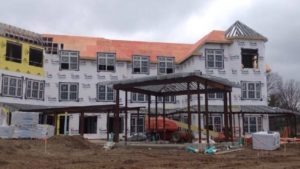Play to your strengths: Lessons from a CCRC expansion project
Aldersgate CCRC in Charlotte, N.C., started as The Methodist Home for independent living in 1945 and grew to encompass skilled nursing, memory support, freestanding cottages and a community center by 2003. Since then? “Nothing,” said Suzanne Pugh, Aldersgate’s president, at a session titled “Strategic and Master Planning: A Case Study” at LeadingAge 2014. After years of inertia and struggling finances, however, Pugh came on board and Aldersgate went into full strategic planning mode.
The community sits on 235 acres in a distressed business area of Charlotte with a diverse population. Pugh and a large team of consultants and stakeholders began the strategic planning process a couple of years ago, creating master planning task forces with residents and front-line staff. The first question to resolve: Do we stay or do we go?
Ultimately, they all agreed to “embrace the place,” Pugh said, to hold onto the larger campus rather than relocating to a more affluent part of Charlotte, where other CCRCs already were ensconced on much smaller, 30-acre sites. The goal was to use the market difference and the expansive property to create a market advantage.
Among the strategies embraced by the planning team:
- Recognize that land is CCRC’s greatest asset; Aldersgate is the single largest landowner in the City of Charlotte. The team is developing broad swaths of green space for the community at large, part of a commitment to moving from simply being a CCRC to creating a NORC (naturally occurring retirement community) that has a CCRC in it.
- Embrace the diversity of the neighborhood and create a community that serves a wider variety of residents and visitors through partnerships with local groups and people.
- Strengthen an already strong reputation for healthcare. A CCRC’s ability to provide excellent healthcare is one of the major decision points for residents to choose one over another, said Brian Schiff, managing director of Brian Schiff & Associates, one of the consultants on the project. So it’s OK, he said, to put healthcare first and independent living second in the planning process. The team agreed that the skilled nursing and memory care portions of their campus were in desperate need of a renovation.
Ultimately, Schiff said, “you have to jump the market, to make others play catch-up.” And the best way to do that, he said, is to identify the areas where you already can jump it, and put your energies there.
The team (including architects CJMW Architecture and Shook Kelley) just recently started the schematic design process for the new campus, which will include 120 more beds in a new skilled nursing facility, a 16-bed addition to memory support and 62 new independent living units. The community spaces and dining venues also will be upgraded—$9 million alone has been earmarked for community spaces that, although non-revenue producing, are important to attract new independent living residents, Schiff said.
Work on the memory support expansion is expected to begin in March; the entire campus is slated for completion in 2018.
Environments for Aging is a sister brand to Long-Term Living.
I Advance Senior Care is the industry-leading source for practical, in-depth, business-building, and resident care information for owners, executives, administrators, and directors of nursing at assisted living communities, skilled nursing facilities, post-acute facilities, and continuing care retirement communities. The I Advance Senior Care editorial team and industry experts provide market analysis, strategic direction, policy commentary, clinical best-practices, business management, and technology breakthroughs.
I Advance Senior Care is part of the Institute for the Advancement of Senior Care and published by Plain-English Health Care.
Related Articles
Topics: Articles , Design , Executive Leadership , Housing , Operations












